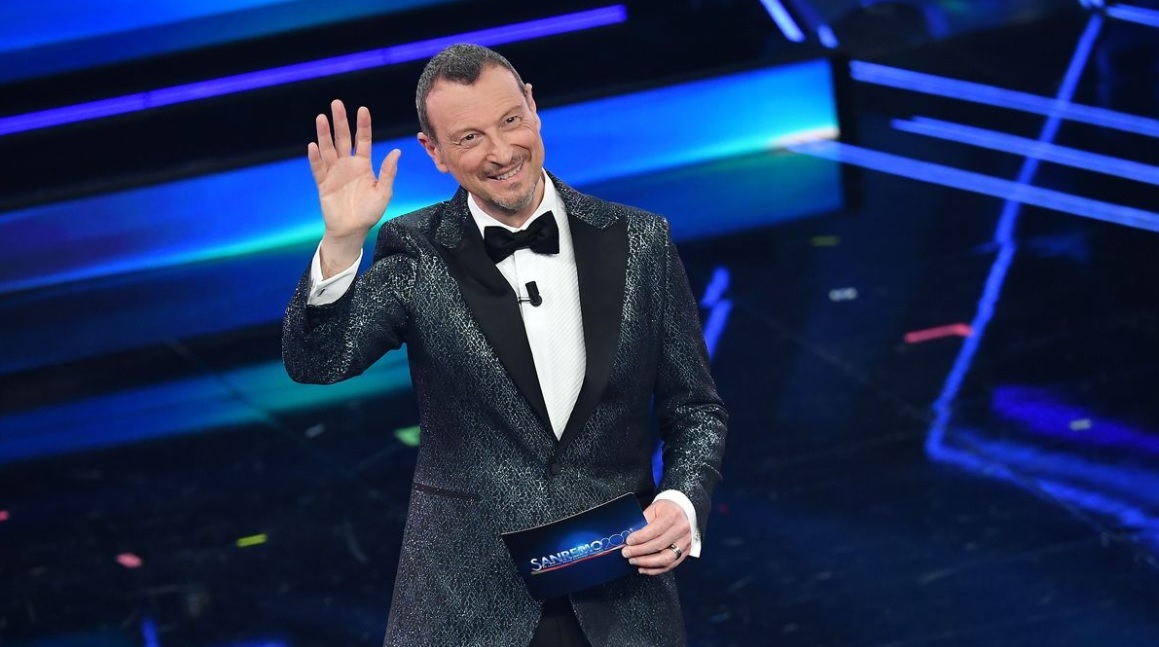Sanremo 2024 is expected to be a great edition. Off the back of Marco Mengoni’s big win with ‘Due Vite’ ten years after his last victory, and subsequent 4th place finish in Eurovision 2023, attention turns to Italy to see what they can come up with next. Of course, next year is very important.
The 2024 edition of Italy’s Sanremo festival will be Amadeus’ last (at least for now). In the Eurovision bubble, we can appreciate that under his reign of selecting the competing entries, and therefore Italy’s Eurovision entries from 2020 onwards, he has been responsible for a 6th and 4th place finish in Mahmood and Blanco’s ‘Brividi’, and Marco Mengoni’s ‘Due Vite’ respectfully, a fan favourite and favourite to win in Diodato’s ‘Fai Rumore’, and Italy’s first win since 1990, ‘Zitti E Buoni’ by the acclaimed Måneskin. But to a local Italian audience he has revolutionised the music contest, and encouraged many young people to not only watch, but strive to take part.
In his last year, Amadeus will want to go out with a bang. And so recently, he has outlined the rules and details of next year’s contest, taking place between the 6th-10th February, beginning with the reassurance that the winner will represent Italy in Eurovision 2024. Let’s take a look at these rules.
The Contestants

While Amadeus is known for his spontaneous decisions, and there is the possibility he may add some more entrants if the pool of songs he receives is of a particularly high quality, as of now it has been announced that Sanremo 2024 will consist of 26 songs and artists, with three of those being Sanremo Giovani winners who earned a spot in the lineup.
This is a change from this year, as there were six Sanremo Giovani winners, gIANMARIA, Shari, Colla Zio, Sethu, Will, and OLLY. The six winners decision was however short lived, as if we journey back, Sanremo 2022 had three Sanremo Giovani winners taking part (Yuman, Tananai, and Matteo Romano).
You can decide whether this is a good or a bad decision based on personal preference. On one hand, this means three less upcoming artists will get the opportunity to perform on the biggest stage in Italy, but on the other hand six winners may be seen as excessive, and (unfortunately) no one this year placed higher than 20th.
From a Eurovision viewpoint, this decision should not be the end of the world, as the voting nowadays makes it unlikely a Giovani winner will win the contest overall, and therefore compete in Eurovision.
The Details of Each Night
Breaking down each night, there are a few changes. Notably, instead of half of the acts presenting their songs on night one, and the other half on night two, next year all 26 artists will perform on the first night for the first time. There is no change in the voting however; the press jury (made up of TV, print, and online representatives) will rank the songs on first impression, and a top five will be announced at the end of the show (as opposed to a full ranking).
Night two introduces second performances, and this is where the performances get split in half. 13 artists will perform here, and the remaining 13 will perform for a second time on night three. On both nights, the artists not performing will be co-hosting in a fun twist. In another variation, while the televote will count for 50% here like this year, the demoscopic jury will be replaced by the radio jury, who will account for the other 50%. Again, at the end, the top five will be announced, instead of a 1st-26th ranking.
Night four, or ‘covers night’, will see the competing artists able to put their spin on an Italian or international song released any time before the end of 2023, allowing more freedom release date wise. Solo artists must perform in a duet with a guest, but groups or duo acts are able to perform alone if they would prefer. The voting percentage remains the same as last year, but once again with the demoscopic jury replaced by the radio jury, seeing them have 33% of the power, the press jury another 33%, and the televote 34%. Another top five will then be presented.
On night five, or the big finale, all acts will traditionally perform again. The same as this year, the televote will have all the power in the voting, and a combined rank from every night will see the top five advance to the superfinal. Again, the same as this year, all five acts will perform again, and with votes reset, the radio jury (in place of the demoscopic jury) will account for 33%, the press jury another 33%, and the televote 34% to finally crown the winner.
Voting
As mentioned, the big change for next year is that the radio jury will be replacing the demoscopic jury. But what does this mean for the competing entries? How will this change the songs/types of artists favoured? To further analyse this, I compared this year’s first impression votes from both groups, and here are their biggest disagreements.

The now replaced demoscopic jury loved the modern pop ballad ‘Supereroi’ by Mr Rain, ranking it 2nd out of 28 songs. However, the radio jury wasn’t as keen, placing it just 8th in a field of 14. They also thought the rock laced power ballad ‘Quando ti manca il fiato’ by Gianluca Grignani was a decent effort, ranking it 17th overall. But the radio jury wasn’t a fan, and with them it finished 13th, just one place from last. Interestingly, the demoscopic jury liked another rock power ballad in ‘Lasciami’ by Modà, which finished just under midtable (15th with them). Although, the press jury placed it 12th out of 14.
Taking a look at the radio jury, they found Mara Sattei’s electropop ballad ‘Duemilaminuti’ impressive, rating it 3rd out of 14, however the demoscopic jury placed it 14th – exactly midtable. The radio jury were also big fans of Madame’s electronic house entry ‘Il bene nel male’, and Tananai’s power ballad ‘Tango’, both of which they placed top 2 respectfully out of 14. Although the demoscopic jury didn’t hate either entry, they both placed lower with them, earning 7th and 8th out of 28 in that order.
Overall from this we can conclude that perhaps the radio jury will assist more modern entries, younger artists, or even female artists (of which infamously none took part in this year’s superfinal) in getting higher placings.
Submissions for Sanremo 2024 close on 27th November, so there is plenty of time for Italian artists and songwriters to get busy on their entries. The contestants will be announced sometime after 1st December.
Who do you want to see representing Italy in Malmö? Do you think Amadeus can pull of another Eurovision win as a parting gift? Let us know!




